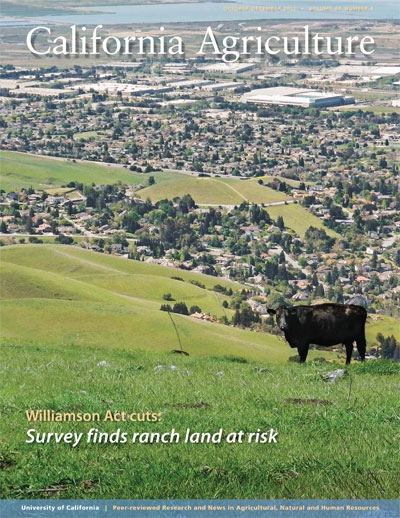
New research reveals that if cuts continue and the act is eliminated, owners of ranchland plan to sell 20 percent of their total acres, according to William Wetzel and his co-investigators. Wetzel is a doctoral candidate in the UC Davis Department of Evolution and Ecology. The findings appear in the October–December 2012 California Agriculture, UC’s peer-reviewed research journal.
“In all, 37 percent of ranchers predicted they would sell some or all of their rangeland without support from the act,” Wetzel said. “Of those who would sell, 76 percent predicted buyers would develop the land for nonagricultural uses — suggesting that a significant amount of California’s open space could be lost.”
For smaller ranchers, tax relief often means the difference between a small profit and a loss, he and his colleagues found. They surveyed 700 ranchers who have Williamson Act contracts, randomly selected from act participants whose land comprises 15 million acres of working ranches and farms. Researchers asked ranchers for plans under a hypothetical elimination scenario.
Under the 1965 act, landowners promise to keep their property in agricultural use for set periods (originally, 10 years at a time). In exchange, they receive significant reductions in property taxes. The state reimbursed counties for most of the lost tax revenue until 2009, when the state virtually eliminated its contribution.
The scientists used both a written questionnaire and geospatial analysis to assess the impacts of eliminating the act. The geospatial analysis revealed that 72 percent of rangeland parcels enrolled in Williamson Act contracts contained habitat “important” or “critical” for statewide conservation goals, as defined by the California Rangeland Conservation Coalition. The Coalition designates 43 percent of enrolled parcels as “critical” for statewide conservation goals.
“Thousands of farmers and ranchers in 53 of California’s 58 counties have participated in Williamson contracts,” said Iara Lacher, co-author and UC Davis doctoral candidate. “California rangelands not only provide forage for cattle, they encompass unique ecosystems that provide habitat for threatened and endangered species. They also form most of the major drainage basins of the state, constantly filtering and purifying the water supply.”
Almost all of California's surface water, including drinking water for millions of people, passes through rangeland. This land -- grasslands, oak woodlands, wetlands, shrublands and desert -- accounts for 57 million of the state's 101 million acres, according to the California Department of Forestry and Fire Protection. Of that, most is used for grazing, 34 million acres. Grazed land itself consists of 18 million privately owned, and 16 million publicly owned, acres (the latter leased for grazing).
Rangeland accounts for more than 10 million acres under Williamson contracts; 5 million acres are prime farmland. Rangeland is considered “non-prime” because the soil is less fertile than that used for intensive agriculture. The distinction depends on the per-acre production potential of a parcel of land.
“Rangeland can provide many ecosystem services precisely because it is not put to intensive use, unlike suburban developments or irrigated agriculture,” Wetzel explained. At the same time, grazed land is the rangeland most at risk of conversion, with the current rate estimated to be 47,000 acres per year. Of ranchers surveyed, 72 percent considered the Williamson Act to be “extremely important” to their operations; 23 percent said they were likely or very likely to end their entire ranching enterprise if they lost this tax relief.
“California ranching is a vulnerable, low-profit industry,” said Dale Manning, study co-author and UC Davis doctoral candidate. “Of those surveyed, 38 percent lost money, 19 percent roughly broke even, and 42 percent made a profit. Of the ranches that made a profit in 2009, 70 percent made less than $10,000.”
Under the original Williamson Act program, contract-holding counties received annual subvention (financial assistance) payments from the state in proportion to their enrollment and to the productivity of the enrolled lands. These funds helped compensate for the tax revenue losses counties faced due to their participation.
Beginning in budget year 2008–2009, California drastically reduced subvention reimbursements to counties as part of a plan to phase out the program. In 2009–2010, California Governor Arnold Schwarzenegger cut state subvention funding to $1,000, essentially eliminating state support.
Before subvention payments were cut, state reimbursements to counties ranged from $5.2 million in heavily agricultural counties such as Fresno, Kern and Tulare to less than $12,000 in more urbanized counties such as Orange and San Bernardino. In 2010, in response to subvention payment loss, Imperial County ended its participation in the program, allowing contracts to expire countywide.
Under mounting budget deficits, a number of counties have placed a moratorium on new Williamson Act contracts because of uncertainty surrounding the future of subvention payments.
The research article, and the entire October–December 2012 issue, can be downloaded at http://californiaagriculture.ucanr.edu.
California Agriculture is the University of California’s peer-reviewed journal of research in agricultural, human and natural resources. For a free subscription, go to: http://californiaagriculture.ucanr.edu, or write to calag@ucanr.edu.
WRITERS/EDITORS: To request a hard copy of the journal, e-mail crllopez@ucanr.edu.
MEDIA CONTACT: William Wetzel, Williamson Act study author, doctoral candidate, Department of Evolution and Ecology, UC Davis, (914) 552-7482, William.wetzel@gmail.com. Available on October 26 and after Nov. 1.
Dan Swezey, UC Davis doctoral candidate and study co-author, is an alternate contact when Wetzel is unavailable, (831) 345-6108, dsswezey@ucdavis.edu.
Rangeland data was taken from the California Department of Forestry and Fire Protection 2010 publication, California’s Forests and Rangelands: 2010 Assessment. http://frap.fire.ca.gov/assessment2010/pdfs/california_forest_assessment_nov22.pdf.